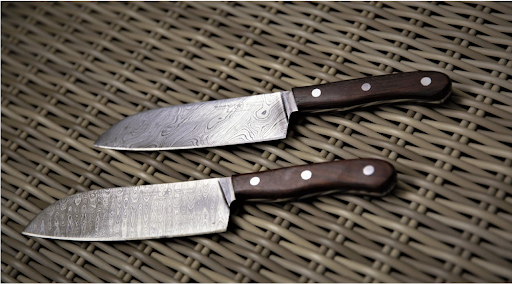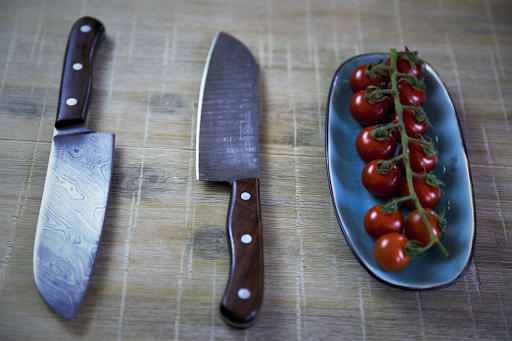Blog
The Art of Handmade Damascus Steel Knives: History and Craftsmanship

Have you ever wondered about the history and intricate craftsmanship behind handmade Damascus steel knives? These remarkable blades are not just tools but works of art with a rich history rooted in ancient Damascus, Syria. The art of forging Damascus steel has been passed down through generations, with skilled artisans using a combination of metals to create blades known for their exceptional strength and exquisite patterns.
This article delves into the fascinating world of handmade Damascus steel knives, exploring the history behind these masterpieces and the skillful techniques employed in their creation. From the origins of Damascus steel in medieval times to its contemporary resurgence, we uncover the secrets behind this timeless art form.
Join us as we journey through history and discover the intricate craftsmanship that goes into forging these exceptional knives. Whether you’re a collector, a chef, or simply someone with an appreciation for the beauty of craftsmanship, this article will provide a deeper appreciation for the art of handmade Damascus steel knives.
The History of Damascus Steel
The history of Damascus steel dates back to medieval times, with its origins rooted in the city of Damascus. The exact techniques used to create Damascus steel have been lost to history, but the blades produced were highly sought after for their exceptional strength and sharpness. Damascus was known for its skilled metalworkers, who developed a reputation for producing blades superior to those made elsewhere.

Damascus steel blades were highly prized by warriors and nobles alike, as they could hold a keen edge and withstand the rigors of battle. These blades were not only functional but also beautiful, with distinctive patterns resulting from the unique forging process. The reputation of Damascus steel spread far and wide, with blades being traded and coveted across the ancient world.
The Craftsmanship Behind Handmade Damascus Steel Knives
The craftsmanship behind handmade Damascus steel knives is a meticulous and intricate process that requires both skill and patience. Skilled artisans, known as bladesmiths, work tirelessly to create these exceptional blades, using traditional techniques passed down through generations.
The first step in crafting a Damascus steel knife is the selection of materials. Damascus steel is typically made by forged welding together multiple high-carbon steel and iron layers. The layers are stacked, heated, and hammered to create a solid metal billet. This process is repeated numerous times to ensure a robust and uniform material.
Once the billet is formed, the bladesmith begins the shaping process. The billet is heated and hammered into the desired shape using hand tools and power hammers. The bladesmith carefully refines the shape, paying attention to the balance and weight distribution of the knife. This step requires a keen eye and a steady hand to ensure the final product is functional and aesthetically pleasing.
After shaping the blade, the bladesmith moves on to the crucial heat treatment step. The blade is heated to a critical temperature and then rapidly cooled to increase its hardness. This process, known as quenching, can be a delicate balance, as the blade must be cooled quickly but not too quickly to avoid cracking or warping. The bladesmith’s experience and expertise are vital in achieving the desired hardness and durability.
Once the blade is hardened, the bladesmith moves on to the final steps of finishing and polishing. This involves grinding away imperfections and refining the edge to ensure a sharp cutting edge. The blade is then polished to a high sheen, often revealing the distinctive patterns and layers of the Damascus steel. The final result is a functional blade and an actual work of art.
The Materials Used in Making Damascus Steel Knives
The materials used to make Damascus steel knives are crucial in creating these exceptional blades. The combination of different metals gives Damascus steel unique properties and distinctive patterns.
Traditionally, Damascus steel was made using a combination of high-carbon steel and iron. High-carbon steel provides strength and hardness, while iron contributes to the blade’s overall toughness. The layers of steel and iron are forge-welded together to create a solid billet, which is then shaped and heat-treated to form the final blade.
In modern times, bladesmiths have experimented with different materials to create variations of Damascus steel. Some may incorporate other types of steel, such as stainless steel or tool steel, to enhance specific properties of the blade. Others may introduce elements like nickel or copper to create unique patterns and colors in the finished blade.
The choice of materials is an essential consideration for bladesmiths, as it directly affects the performance and aesthetics of the finished knife. Each combination of metals will produce a slightly different blade with its strengths and characteristics. The skill of the bladesmith lies in selecting suitable materials and forging them together to create a functional and visually stunning blade.
The Forging Process of Damascus Steel Knives
The forging process of Damascus steel knives is a labor-intensive and time-consuming craft that requires precision and skill. Each step contributes to the final result, with the bladesmith carefully manipulating the metal to create the desired shape and pattern.
The first step in the forging process is the preparation of the billet. The bladesmith selects the appropriate combination of metals and stacks them together to form a solid block. The layers are often interleaved to create a pattern, with each layer contributing to the overall aesthetics of the blade. Once the layers are stacked, the billet is heated and hammered to forge the metals together.
The bladesmith then begins the process of shaping the blade. The billet is heated and hammered into the desired shape using hand tools and power hammers. This requires careful attention to detail, as the bladesmith must ensure the blade is symmetrical and balanced. The shaping process may take several iterations, with the bladesmith frequently heating and hammering the blade to refine its shape.
Once the blade is shaped, the bladesmith moves on to the crucial heat treatment step. This involves heating the blade to a critical temperature and then rapidly cooling it to increase its hardness. The blade is then tempered to reduce its brittleness and improve its toughness. The bladesmith’s experience and expertise play a crucial role in this step, as the precise temperatures and timing are critical to achieving the desired hardness and durability. After heat treatment, the blade is refined through grinding and polishing. The bladesmith carefully removes imperfections and refines the edge to ensure a sharp cutting edge. The blade is then polished to a high sheen, revealing the intricate patterns and layers of the Damascus steel. This final step brings out the blade’s true beauty, showcasing the bladesmith’s skill and artistry.
